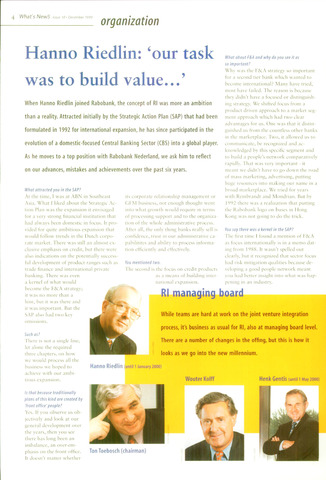Hanno Riedlin: 'our task
was to build value...'
organization
Rl managing board
4 What's NewS Issue 10 December 1999
When Hanno Riedlin joined Rabobank, the concept of Rl was more an ambition
than a reality. Attracted initially by the Strategie Action Plan (SAP) that had been
formulated in 1992 for international expansion, he has since participated in the
evolution of a domestic-focused Central Banking Sector (CBS) into a global player.
As he moves to a top position with Rabobank Nederland, we ask him to reflect
on our advances, mistakes and achievements over the past six years.
While teams are hard at work on the joint venture integration
process, it's business as usual for Rl, also at managing board level.
There are a number of changes in the offing, but this is how it
looks as we go into the new millennium.
Wouter Kolff
Henk Gentis (until i May 2000)
Ton Toebosch (chairman)
What attracted you in the SAP?
At the time, I was at ABN in Southeast
Asia. What I liked about the Strategie Ac
tion Plan was the expansion it envisaged
for a very strong financial institution that
had always been domestic in focus. It pro-
vided for quite ambitious expansion that
would follow trends in the Dutch corpo-
rate market. There was still an almost ex-
clusive emphasis on credit, hut there were
also indications on the potentially success-
ful development of product ranges such as
trade finance and international private
banking. There was even
a kemel of what would
become the F&A strategy;
it was no more than a
hint, but it was there and
it was important. But the
SAP also had two key
omissions.
Such as?
There is not a single line,
let alone the required
three chapters, on how
we would process all the
business we hoped to
achieve with our ambi
tious expansion.
Is that because traditionally
plans of this kind are created by
'front office' people?
Yes. If you observe us ob-
jectively and look at our
general development over
the years, then you see
there has long been an
imbalance, an over-em-
phasis on the front office.
It doesn't matter whether
its corporate relationship management or
GFM business, not enough thought went
into what growth would require in terms
of processing support and to the organiza
tion of the whole administrative process.
After all, the only thing banks really sell is
eonfidence, trust in our administrative ca-
pabilitites and abilitv to process informa-
tion efficiently and effectively.
You mentioned two.
The second is the focus on credit products
as a means of building inter
national expansion.
What about F&A and why do you see it as
50 important?
Why was the F&A strategy so important
for a second tier bank which wanted to
become international? Many have tried,
most have failed. The reason is because
they didn't have a foeused or distinguish-
ing strategy. We shifted focus from a
product driven approach to a market seg
ment approach which had two clear
advantages for us. One was that it distin-
guished us from the countless other banks
in the marketplace. Two, it allowed us to
communicate, he recognized and ac-
knowledged by this specific segment and
to build a people's network comparatively
rapidly. That was very important - it
meant we didn't have to go down the road
of mass marketing, advertising, putting
huge resources into making our name in a
broad marketplace. We tried for years
with Rembrandt and Mondrian. But by
I 992 there was a realization that putting
the Rabobank logo on buses in Hong
Kong was not going to do the trick.
You say there was a kernei in the SAP?
The hrst time 1 found a mention of F&A
as focus internationally is in a memo dat-
ing from 1988. It wasn't spelled out
clearly, but it recognized that sector focus
had risk mitigation qualities because de-
veloping a good people network meant
you had better insight into what was hap
pening in an industry.
Hanno Riedlin (until 1 January 2000)

